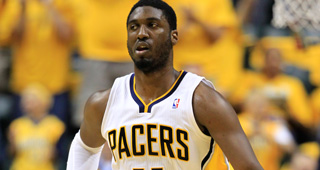The Indiana Pacers used an inside-out approach in their 82-71 win over the New York Knicks in Game 3. Typically, the Pacers feed Roy Hibbert early to establish an inside presence. On Saturday night, Indiana hit a number of outside shots in the first quarter and rode Hibbert late.
New York gave Indiana room to shoot from deep and they responded by attempting seven of their first 12 shots from three-point. The Pacers made their first three attempts before going 1-for-12 over the remainder of the first half.
They finished the game 10-for-33 on three-point attempts. The Pacers averaged 19.7 three-point attempts per game in the regular season and hit just 34.7 percent (22nd in the league). Frank Vogel’s team isn’t going to win many games by catching fire from the outside, but they were more than happy to take open shots in this one. In fact, they might have been a little too willing to settle for jump shots (30.3 perent from deep) -- but it’s hard to argue given the space they were allowed.
Indiana doesn’t shoot the basketball well, especially when the starters are on the bench and Mike Woodson made a great move in the second quarter in response. When Amar’e Stoudemire returned to the floor and Vogel shifted to the second unit, he employed a 1-2-2 zone. The Pacers didn’t have the right personnel to shoot over the zone until George Hill and David West were sent back out on the floor.
The Pacers built a 10-point lead at one point in the second quarter, but the Knicks trimmed the advantage to just three with a late run going into halftime. At that point, things looked very good for New York.
Carmelo Anthony had 13 first-half points on just six shots, about as efficient as you will see him in the playoffs. Heading into Game 3, Anthony was averaging 29.3 points on 26.8 shots.
After making a number of tough shots early on, Anthony cooled off in the second half. He missed his final seven shots after making six of his first nine attempts. His 21 points tied a low for this postseason and his 16 shot attempts were his lowest by far (he attempted 23 in Game 6 against Boston).
The Pacers and Knicks combined to shoot 35.1 percent from the floor on Saturday night. That lends itself to a lot of missed shots and Indiana gobbled them up. They won the rebounding battle by thirteen and collected 18 offensive rebounds.
That takes us to the star of the pivotal game:
Hibbert’s Career Game
Hibbert enjoyed arguably the best playoff game of his career, recording 24 points and 12 rebounds (eight offensive). He failed to register a block, but altered a number of shots as usual. He was a game-high +20 and showed off a number of nifty post moves against Tyson Chandler. New York doesn’t have an answer for his size, rebounding and defense.
His play in this series shows just how far he has come since he entered the league as a lumbering center from Georgetown. He often tripped over his own feet and jumping straight up to defend penetration was too much to ask early in his career. Learning to how to play suffocating defense without fouling has allowed him to remain on the floor and break down opposing offenses.
He played 40 minutes on Saturday night, a different look he told Doris Burke after the game in response to Stoudemire’s return, and showed high energy down to the last minute. The last time Hibbert played 40 or more minutes? In the third game of the season (Nov. 3), when he logged 43 minutes (12 points, 10 rebounds and 6 blocks) against the Kings.
New York’s Offensive Three
The Knicks struggled as a team, shooting 35.2 percent from the field and 3-for-11 from three, but were ultimately doomed by their three most important offensive players.
Anthony, J.R. Smith and Raymond Felton combined to shoot 11-for-36 in Game 3. The rest of the team went 14-for-35 -- including a 3-for-10 performance from Iman Shumpert -- as they were unable to rescue their stars.
The remarkable thing was that the duo of Anthony and Smith (combined 10-for-28) made a number of seeming impossible shots against tight Indiana defense in the second and third quarters. They then proceeded to miss the attempts in which they did have some daylight.
Surviving Rough Nights
The defense was top notch, but offensively the Pacers were far from perfect despite the double-digit win. Hill struggled with his shot from the opening tip (finishing with 17 points on 5-for-16 shooting). He attempted 12 three-pointers and missed a handful of his trademark runners. Hill did, however, help on the glass (six rebounds).
West logged 11 points and 12 rebounds, but was a dreadful 2-for-8 in the first half and was whistled for a technical foul with more than seven minutes left in the second quarter. If some of his inside looks in the first half had fallen, this game might have been over at halftime.
Paul George had a nice-looking line: 14 points, eight rebounds, eight assists and five steals, but also committed five turnovers and shot 4-for-17 from the field. With New York playing off, he went 2-for-12 from three. Woodson’s strategy to force the Pacers out to the three-point line worked, but the Knicks simply couldn’t score enough on their own. That Indiana was able to absorb a poor shooting night from Hill, George and West (13-for-44) and still win relatively comfortably showcases how well they match up against the Knicks. The trio actually had a lower shooting percentage than Anthony, Felton and Smith.



